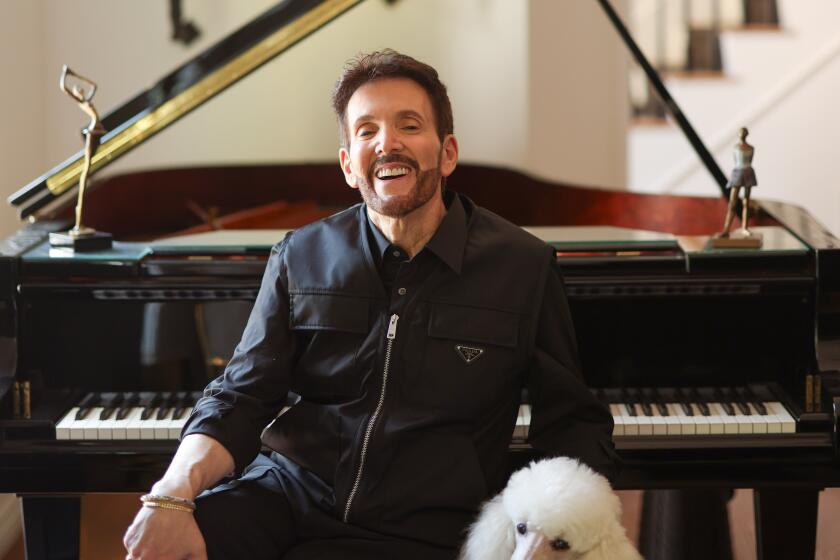Indie Focus: In âAgora,â a faceoff between faith and science
Something of an action film for intellectuals, in that it focuses on sectarian power struggles and violence stemming in part from scientific inquiry, Spanish filmmaker Alejandro AmenĂĄbarâs âAgoraâ tells the story of the conflict between pagans and the growing ranks of Christian believers as they wrestle for control over the 4th century city of Alexandria.
Starring Rachel Weisz as Hypatia, a pagan teacher and astronomer about whom little is known historically, âAgoraâ â opening Friday in Los Angeles â places special emphasis on the geocentric/heliocentric debate, whether the Earth is the center of the universe or if it rotates around the sun. Despite its ancient setting, the film manages to feel timeless with its depiction of the friction between religious beliefs and scientific discoveries as well as its portrayal of how new ideas struggle for acceptance.
âThe overall feeling I had when I closed the script for the first time was, âWow, this is a movie about today. Itâs a contemporary story set in the 4th century,â â Weisz said recently. âWhat struck me was how little has changed. We can go to the moon and we have antibiotics and human rights in most countries of the world, but so much hasnât changed.â
The previous film by the 38-year-old AmenĂĄbar, 2004âs âThe Sea Insideâ starring Javier Bardem, won an Academy Award for best foreign language film. Made for roughly $75 million, the English-language âAgoraâ was trimmed of some 15 minutes after its premiere last year at Cannes and became a box-office smash when it was release in Spain last fall. Nominated for 13 Goya awards â the Spanish Oscars â âAgoraâ took home seven prizes.
For AmenĂĄbar (who shares screenplay credit with Mateo Gill), there was a push-pull between his desire for historical accuracy â What might it have been like to live in that time? â and the simple fact that there is no way to really know. Similarly, he was forced to extrapolate on ideas and theories that Hypatia might have had, discoveries that she conceivably could have made, even if there is no proof that she did. The destruction of the library of Alexandria, as portrayed in the film, was an intellectual setback that may have hindered scientific understanding by hundreds of years.
âOne of the things we totally speculated on was how far she got with her theories,â AmenĂĄbar said. âWe thought since almost nothing of her work has been preserved, why donât we speculate with that? I wanted to go as far as possible.â
âI guess the most important thing to me was even though itâs about ideas, what I wanted to portray was passion,â said Weisz. âI just thought Iâm really passionate about what I do, and why canât she be as passionate about science? I didnât want her to be cold. Thereâs no love story, her love affair is with her work. To show passion for ideas, itâs definitely challenging.â
Despite having old-fashioned crowd scenes with more than 1,000 extras and a particular depiction of the sheer brutality of death by stoning, some of the filmâs most exciting sequences turn the act of creative thinking into something thrilling. The scene where Hypatia has the breakthrough to a heliocentric model of the universe has the pacing and feel of an adrenaline-surging action scene.
âYou donât try to project anything,â said Weisz of how one portrays an outward sense of inner gears turning. âI was literally just thinking it. If you think the thought she is thinking is something completely revolutionary about the universe, itâs exciting. If you really start thinking about it, just let the thought in, itâs not a dry, boring thought.
âItâs imagination and thatâs all I do for a living, I use my imagination. So in a way it was totally pure to me as a professional daydreamer.â
AmenĂĄbar shot the film on the island of Malta, creating massive sets overseen by production designer Guy Dyas, who has subsequently worked on the new Christopher Nolan film, âInception.â The film has an epic sweep, including shots where the camera swoops overhead or even spins around on its axis that would have been easier to achieve with computer effects, but AmenĂĄbar insisted on practical shots on location.
âI tried not to do anything you could not do physically,â he said. âTo me it was important to think we had the privilege of going back to the past for a few days. Itâs perfectly honest trying to do that digitally, but for me I wanted to see the actors interacting with space, I wanted to see the sweat of the actors combine with the walls. I wanted them being there. I know itâs going backwards with whatâs being done today, but you get a different feeling.â
With its mix of old-fashioned, large-scale, cast-of-thousands antiquity filmmaking and AmenĂĄbarâs interest in the history of science and thought, âAgoraâ seeks to reconcile a mass of internal contradictions, becoming something of a modern epic of ancient times, an adventure film about ideas.
âThe movie is not only a tribute to scientists, it is a tribute to people who have that ability of promoting knowledge,â added AmenĂĄbar. âThe real heroes in the movie are not the ones who use their swords but the ones who use their mind.â
âIt definitely has ideas in it that you donât normally see in blockbusters,â said Weisz. âBut why not? Why not have a blockbuster about science?â
Clicking on Green Links will take you to a third-party e-commerce site. These sites are not operated by the Los Angeles Times. The Times Editorial staff is not involved in any way with Green Links or with these third-party sites.
More to Read
Only good movies
Get the Indie Focus newsletter, Mark Olsen's weekly guide to the world of cinema.
You may occasionally receive promotional content from the Los Angeles Times.











